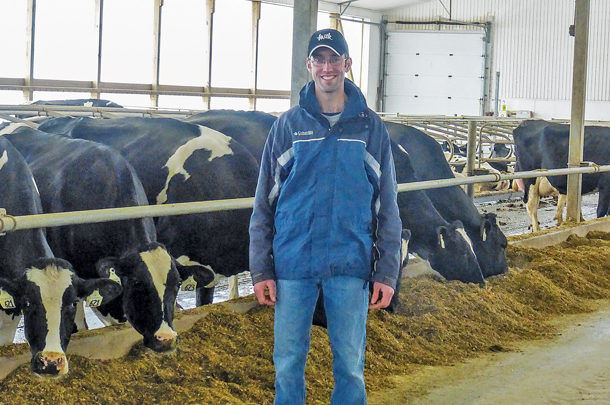The HMS allocates points for performance in six different areas. It is a great tool for monitoring progress from year to year, and it allows herd owners to benchmark themselves against others.
The total score, maximized at 1,000 points, cumulates the following indicators: milk value (500), udder health (150), age at first calving (100), calving interval (50), longevity (100) and herd efficiency (100).
The following herds achieved top rankings in Canada: 1) Larenwood Farms, Ontario; 2) Ferme Barjo Inc., Québec; 3) Summitholm Holsteins, Ontario; 4) Sunny Point Farms Ltd., Nova Scotia; and 5) Ulmar Holsteins, Ontario.
Three questions were asked to the managers of each of the herds, who respectively included Chris McLaren, Amélie Tremblay, Ben Loewith, Phillip Vroegh and Ashley Hall. Here is what they had to say:
1. Larenwood Farms (Photo above)
Owners: Chris, Grant and Dan McLaren
Drumbo, Ontario
- 170 Holsteins (90 milking)
- An average of 13,925 kilograms milk and 1.5 kilograms fat per cow per day; 2X milking in parallel parlour
- Sand-bedded freestall barn
- TMR fed to three separate groups: 65 percent roughage; haylage and corn silage stored in bunker silo; high-moisture corn stored in a tower silo
- Farm 500 acres
- Total Herd Management Score: 996
What major benefits do you see in having a top-performing herd?
McLaren: It is an honour to achieve this top ranking against so many great herds; we won last year in Ontario, and now being the top in Canada is a great surprise. This honour shows that we set up management protocols that are giving us the edge in herd performance and profitability.
Tremblay: To rank first in Quebec and second in Canada was a nice surprise for us. Before, we knew we were among the best in Quebec with a percentile rank of 99 over the last eight years.
We manage our herd the best we can in order to pay our debt since we purchased the farm only five years ago. Having a high-performance herd brings us a lot. We can reduce our need for employees; one part-time is enough. Having fewer animals allows us to take good care of each one.
Loewith: While it is, of course, a wonderful distinction to be one of the top-listed herds, we feel that striving to improve and excel in each of the categories is more important than where we land on the list. First and foremost, we are trying to maintain a profitable dairy operation, and the management categories are an excellent way to measure our progress.
Vroegh: We think it is great to be recognized for having one of the top-performing herds in Canada. This definitely is a team effort, with all of the staff having a huge part in the results.
In our opinion, having a high-producing, healthy herd results in a more profitable farm. Our goal is to produce as much milk and components per cow as possible without sacrificing cow health and longevity.
HALL: We are very proud to have achieved the fifth top-managed herd in Canada this year. Our family works hard to ensure every task is done with cow comfort, health and production in mind. This award means our daily protocol, teamwork and herd management philosophy is working to its best ability and that we are making profitable decisions.
2. Ferme Barjo Inc.
Owners: Amélie Tremblay and Dominique Bard
Baie-Saint-Paul, Quebec
- 70 Holsteins (44 milking)
- An average of 12,500 kilograms milk, 4.2 percent fat, 3.35 percent protein and 1.6 kilograms fat per cow per day; 3X milking
- Tiestall barn
- Round bale silage (no dry hay) and dry concentrates served by a robot five times per day
- Total Herd Management Score: 979
What are the most recent improvements you have made in your operation?
McLaren: Our sand-bedded freestall barn built four years ago was the key to improve the performance of our herd, and the great cow comfort achieved allows for much more longevity. Our focus is to maximize feed intake, and we selected cows with enough capacity.
We have strict reproduction protocols, and cows go on an Ovsynch program if not bred at 70 days in milk; our pregnancy rate stands between 25 and 30 percent.
Cow transition program is very important; a strict protocol starts two to three weeks before they calve. We are careful about our genetic selection program; we concentrate on health and fertility traits such as somatic cell score, immunity and daughter fertility.
Tremblay: We improved dry cow comfort by transforming half of the straw barn into a straw yard. It was a great success; cows are in great shape after calving. We also adopted the short dry period of 35 days. It gives us more lactating cows and fewer dry cows.
Four years ago, we went on 3X milking and acquired a round bale chopper, which has contributed to increasing the herd average to 12,500 kilograms (previously 10,300 kilograms). We improved forage conservation by using a silage preservative and more plastic coat on each round bale. For nearly 10 years, we have selected for health and fertility traits in addition to production.
Loewith: In the last year, we moved half of the milking herd into a new freestall barn, lowering our stocking density from 125 percent down to less than 100 percent. This allowed us to gain more than one hour per day of additional lying time for the cows.
We also installed [an activity monitoring] system for our heifers, which has tightened up our heifer-breeding program. Late in the year, we also dug out the back of our sand-bedded stalls, as they were becoming quite compacted and hard. This also greatly improved the stall comfort and measurable lying times.
Vroegh: This being the first year our farm has received a management score, we had not previously focused on the score as a benchmark. We have always focused on cow comfort, and in recent years, we really focused on heifer growth so we can calve heifers out earlier.
Poor production, low fertility and high somatic cell score cattle are aggressively culled, regardless of their classification. Having just completed a new dry cow and transition cow facility, we are excited about the opportunities for better dry cow comfort and transition cow health.
HALL: The most noticeable improvement would be the success of our transition program. Meticulous management of body condition score, especially during the dry period, has improved our transition cow health and their ability to meet peak production and higher persistency.
Another recent change we have made is closely monitoring how we distribute sand in our sand stalls; using beach sand with the lowest clay content and ensuring sand is fully dry when leveled in the stall has helped us improve our somatic cell score during summer months. We also switched to using a post-dip that adds an additional layer of protection to prevent mastitis infection.

3. Summitholm Holsteins
Owners: Carl, Dave and Ben Loewith
Lynden, Ontario
- 850 cows (400 milking)
- An average of 12,800 kilograms milk, 3.85 percent fat, 3.25 percent protein and 1.6 kilograms fat per cow per day
- Sand-bedded freestall barn
- TMR fed to three separate groups; heavy on corn silage
- Farm 800 acres
- Five full-time employees (including owners) and 10 part-time for milking
- Total Herd Management Score: 972

4. Sunny Point Farms Ltd.
Owner: Philipp Vroegh
Hants County, Nova Scotia
- 625 Holsteins (300 milking)
- An average of 13,300 kilograms milk, 4.15 percent fat, 3.25 percent protein 1.88 kilograms fat per cow per day, 3X milking in a parlour
- Sand-bedded freestall barn
- TMR fed to three separate groups; corn silage, dry corn and alfalfa; silage stored in bunker silos
- Farm 800 acres
- Six full-time employees
- Total Herd Management Score: 969
What would you recommend for dairy producers wanting to reach this top level of management?
McLaren: There are no shortcuts to achieve it. It starts with great cow comfort and good advice from our nutritionist and veterinarian. You need to care about management details, especially transition, reproduction and health. Always ask yourself, “How can I be better?” Find your “bottleneck” in herd performance and work to improve it.
Tremblay: Get surrounded with a team of bright advisers who feel involved in the success of your dairy farm. You need to work with consistency, accuracy and rigor in everything. To be constantly informed and continuously trained is crucial.
Visit the best and take notes to be inspired to apply the best practices. Do not be swayed by images and patterns, only by facts and figures. Perform logical genetic choices; in our opinion, you can’t think expo and productivity at the same time. You must define accurate breeding goals and follow them closely.
Loewith: Start by picking your battles: Decide what the biggest bottleneck in your operation is and, with the help of advisers, come up with a strategy to overcome that obstacle. If you ask your veterinarian or nutritionist what protocols their best clients are implementing, they will most likely be happy to share that information.
Putting protocols into place that will drive your results are the easy part; the more difficult part is making sure everyone on the farm is on the same page so that the protocols are followed every day, including days when you become busy in the fields or short of help.
Vroegh: We have quarterly meetings with our veterinarian and nutritionist with key staff to talk over any current issues or opportunities. We tour farms and go to seminars as much as possible because we always can learn something.
HALL: There are three philosophies we hold our team accountable to which we feel would work well for many dairy producers:
- 365 days a year, regardless of fieldwork or any other tasks, our cows are our first priority.
- Consistency in our daily routine and attention to fine detail have allowed us to achieve good management results.
- Everyone on our team knows the long-term goals of our farm that impact our day-to-day protocols and reasons behind our management decisions.

5. Ulmar Holsteins
Owners: Hans, Marlise, Marco Pfister and Ashley Hall
Mitchell, Ontario
- 165 cows (75 milking) cows
- An average of 11,945 kilograms milk, 4.24 percent fat, 3.17 percent protein, 2X milking in a parlour
- Sand-bedded freestall barn
- Feed stored in silos and fed using a conveyer belt system
- Farm 550 acres: Major crops are alfalfa, corn, soybeans and wheat
- Two owners work full-time, and two spouses work part-time
- Total Herd Management Score: 961
Attention to cow comfort, their transition period and to strictly respected management protocols appear to be the common denominator of the best herd managers.
In addition, they are continuously working on improvements to their practices and animal environment, suggesting that they may well remain among the best for the coming years. PD
PHOTO 1: Larenwood Farms, Owners: Chris, Grant and Dan McLaren. Photo provided by Chris McLaren.
PHOTO 2: Ferme Barjo Inc., Owners: Amélie Tremblay and Dominique Bard. Photo by Emélie Bernier.
PHOTO 3: Summitholm Holsteins, Owners: Carl, Dave and Ben Loewith. Photo provided by Summitholm Holsteins.
PHOTO 4: Sunny Point Farms Ltd., Owner: Philipp Vroegh. Photo provided by Sunny Point Farms Ltd.
PHOTO 5: Ulmar Holsteins, Owners: Hans, Marlise, Marco Pfister and Ashley Hall. Photo provided by Ulmar Holsteins.

-
Mario Séguin
- Freelance Writer
- Saint-Hyacinthe, Quebec








